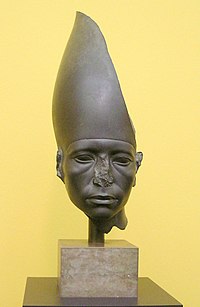Head of Amenemhet III, Ny Carlsberg Glyptotek AEIN 924
| Head of Amenemhet III. | |
|---|---|

|
|
| material | Greywacke |
| Dimensions | H. 46 cm; |
| origin | Unknown |
| time | Middle Kingdom , Dynasty 12 , 1914 to 1879/76 BC Chr. |
| place | Copenhagen , Ny Carlsberg Glyptotek , ÆIN 924 |
At the head of Amenemhet III. Ny Carlsberg Glyptotek AEIN 924 is one of the masterpieces of sculpture of the Middle Kingdom from ancient Egypt .
Amenemhet III. (1842 to 1795 BC) was the last significant ruler of the 12th Dynasty and ruled for about 45 years. Even under his predecessor Sesostris III. the representation of the Egyptian ruler in the sculpture changed radically and no longer shows an idealized, young ruler, but the old age image of a king plagued by the worries of the government. This model was followed by his son Amenemhet III, whose sculptures can be divided into two groups. There are those that show the young ruler and those that reproduce an older, slightly worn out ruler.
Ny Carlsberg Glyptotek AEIN 924 shows the head of Amenemhet III. and is made of greywacke . It is 46 cm high and was bought in Cairo in 1894 by Valdemar Schmidt (1836–1925), then curator of the museum's Egyptian collection, for 2,000 francs. The former location of the head is unknown. Parts of the crown are missing, the nose is chipped off and the ears are partially broken off. There are hardly any known busts from ancient Egypt. The head was certainly once part of a statue .
Amenemhet III. wears the white crown , which was the crown of Upper Egypt . There is no sign of a cobra or a beard, both insignia expected on a royal statue. The stone is polished smooth. There are no hints of the eyebrows. The mouth is wide. The nasolabial folds are clearly worked out, as are strong eye rims. It has been suggested to date the head to the late period, an era in which works of the Middle Kingdom were often copied. Today the work is dated under Amenemhet III. however, as safe.
The head may have come from the ruler's temple at Hawara . Inscriptions are known from the Wadi Hammamat that tell of expeditions of the ruler to break gray wacke for the temple of the ruler. Larger statues of the ruler for Hawara are mentioned in the inscriptions, but it seems likely that material for smaller statues was also broken.
Individual evidence
- ^ Oppenheim, in: Adela Oppenheim, Dorothea Arnold , Dieter Arnold andKei Yamamoto (editors): Ancient Egypt Transformed, The Middle Kingdom , 84
literature
- Mogens Jørgensen: Ny Carlsberg Glyptotek. Catalog Egypt. Volume 1: 3000-1550 BC Glyptotek, Copenhagen 1996, ISBN 87-7452-202-7 , pp. 168-169, no. 68.
- Lise Manniche: Egyptian Art in Denmark. Gyldendal, Copenhagen 2004, ISBN 87-02-00408-9 , pp. 29, 84-85.
- Adela Oppenheim: Head of a Statue of Amenemhat III Wearing the White Crown , in: Adela Oppenheim, Dorothea Arnold , Dieter Arnold andKei Yamamoto (editor): Ancient Egypt Transformed, The Middle Kingdom , New York 2015 ISBN 978-1-58839-564 -1 , pp. 84-85, No. 27